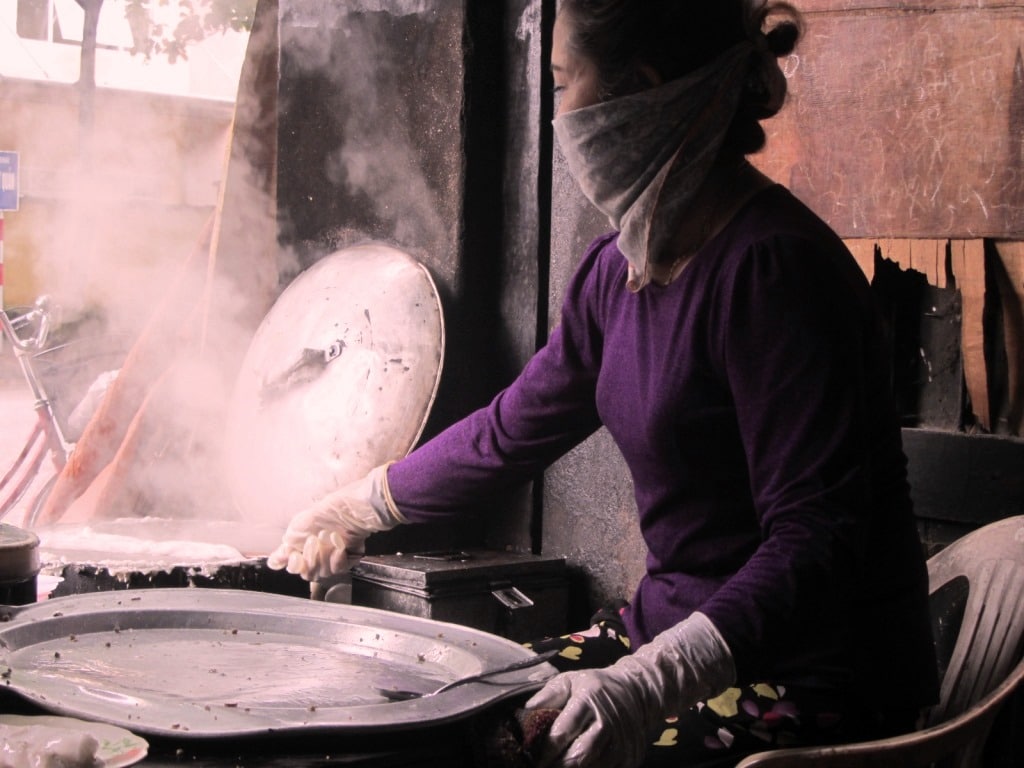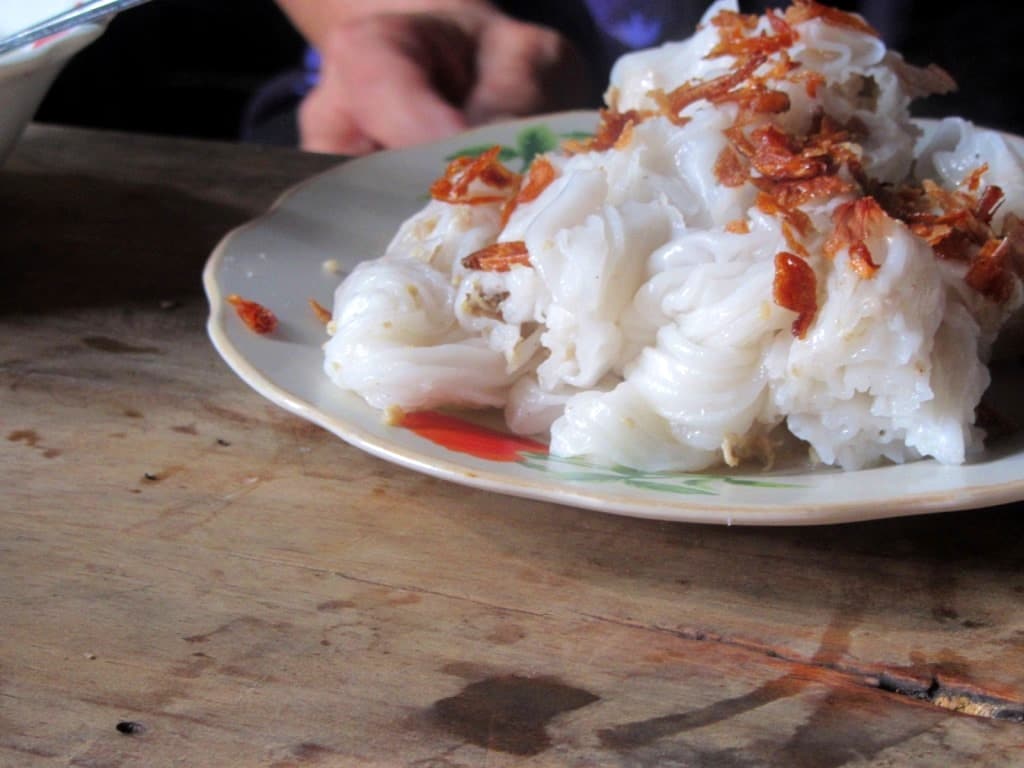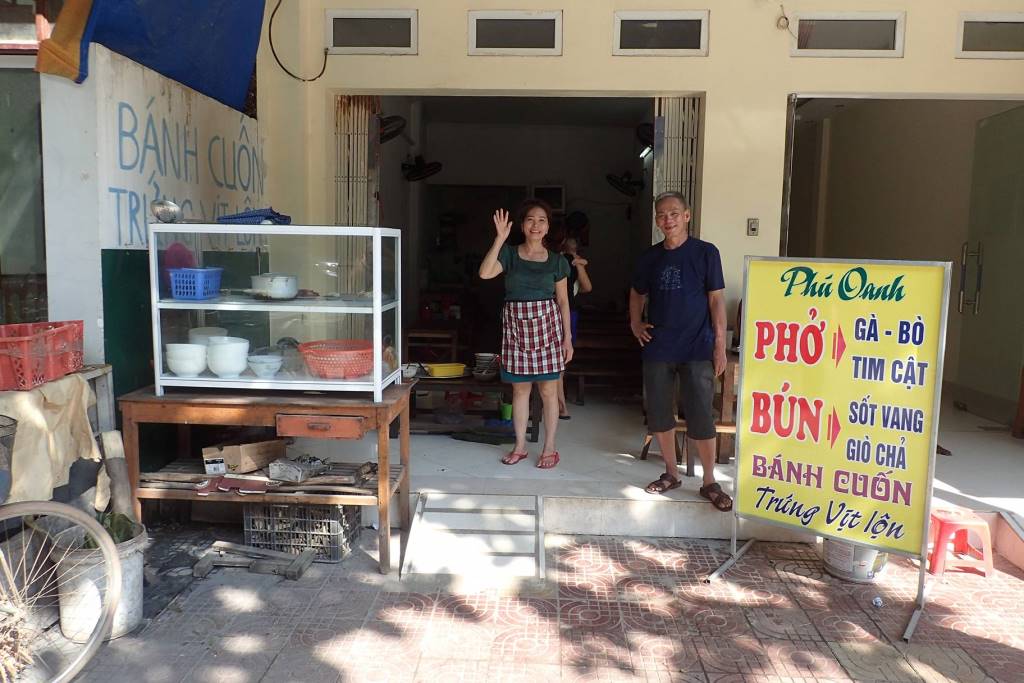Last updated September 2019 | Words and photos by Vietnam Coracle | 12 comments
This post was last updated 6 years ago. Please check the comments section for possible updates, or read more on my Updates & Accuracy page.
INTRODUCTION | GUIDE | MAP | RELATED POSTS
This is an ode to a breakfast noodle house I visited in Ha Giang, the provincial capital of Vietnam’s northernmost frontier. Although it has changed considerably since I first ate there, in late September 2014, the experience has been echoing inside me ever since. The noodle house is a small, family-run business, specializing in bánh cuốn (steamed rice flour rolls), a favourite breakfast in the northern provinces. The best informal dining establishments in Vietnam are those that find the perfect balance and interplay of three key elements: food, people, and place. This can result in a deeply satisfying and memorable experience. Breakfast in Ha Giang was one such occasion.
*(IMPORTANT NOTE: please see updates at the bottom of this article)

A memorable experience: breakfast in Ha Giang
[Back Top]
GUIDE: BREAKFAST IN HA GIANG
Address: Phú Oanh, 31 Nguyen Thai Hoc Street | Price: 20,000-40,000vnd
A Memorable Breakfast on the Northern Frontier
Ha Giang is a small, fairly prosperous city on the banks of the muddy Lô River, some 300km north of Hanoi. Green limestone mountains encircle the city, their crenulated ridges forming a fortified wall around this provincial capital, beyond which lies China. Exceptionally bleak on cold, misty, wintry days, Ha Giang is at its most attractive during the warm, clear weather of late summer. In the rainy season the river floods regularly, causing the water-level to rise above the ground-floors of the townhouses along the riverfront.

A river runs through it: Ha Giang in late summer
Ha Giang is the gateway to one of the most remote and dramatic landscapes in Vietnam: the Dong Van Karst Plateau Geopark. There’s a tangible excitement among the handful of travellers who make it to this city, as they prepare themselves to ride the legendary Ha Giang Extreme North Loop. As such, breakfast in Ha Giang has an edge: this could be the meal that kick-starts a day you may remember for a long time to come. At the southern end of Nguyễn Thái Học Street, along the east bank of the Lô River, is where I found my breakfast.

Ha Giang is the gateway to the dramatic landscape of the Dong Van Karst Plateau Geopark
The sign outside (see important updates at bottom of this post) does nothing to distinguish it from any other Vietnamese roadside eatery: On the pavement a generic metal placard reads, ‘Steamed rice rolls. Duck eggs. Noodles.’ (Bánh cuốn. Trứng vịt lộn. Bún.) Like many great places to eat in Vietnam, it has no name or street number. The family thought it very strange that I would even ask for an address – in a town like Ha Giang, people just know where the good food is. However, look for number 31 Nguyễn Thái Học Street and you’ll see the noodle house next door. [MAP]

A generic sign for a special noodle house
The dilapidated façade of this nameless noodle house caught my eye immediately. A ramshackle, single-storey shophouse, the brick, wood, and concrete exterior is so blackened by cooking smoke and soot that it appears to have suffered through a serious fire. Floor to ceiling wooden shutters open onto a small front yard where a wooden table hosts the tea and tobacco station, typical of northern dining. A bamboo blind is haphazardly rolled up above the entrance: during the rains, or on cold winter mornings, the blind is rolled down to shelter customers from the chill.

Ramshackle: the smoke-stained facade of the noodle house in Ha Giang
Tucked into a corner of the premises, a black-stained, brick hearth represents the kitchen. A clutter of rough-cut, wooden planks lean against the wall. Every fifteen minutes one of these is fed into the fiery hearth to replenish the flame beneath large pots and pans.

Feeding wood into the hearth at the Ha Giang noodle house
Inside the noodle house, the floral-patterned tiled floors are strewn with tissues, squeezed halves of kalamansi, tooth picks, puddles of soup and other food-related detritus (always a good sign in Vietnam). The plaster is peeling off the bare, concrete walls which have aged, moulded and burned in varying degrees, creating a collage of textures and subtle, overlapping plains of colour, reminiscent of a Rothko canvas.
 Family, food, and a certain rustic charm to the decor at the Ha Giang noodle house
Family, food, and a certain rustic charm to the decor at the Ha Giang noodle house
Diners sit at wooden tables on wooden benches and stools, hunched over their breakfasts. The wooden surfaces are chipped and scratched, but the fluid wood grain is still visible. A couple of naked light-bulbs swing from the high ceiling, but all light – even the daylight – is obscured by clouds of cooking smoke and the fumes rising from bamboo pipes of Lao tobacco, smoked at the communal tea station out front.

Smoke screen: steam and tobacco smoke fill the Ha Giang noodle house
In a way, each and every customer has left his or her mark on this breakfast house. Like an ancient, revered monument, its scars tell a story, and their presence add to the character of the building. This soup house wears its years with dignity. I am not repulsed by its dilapidated state, quite the opposite, I am drawn to it precisely because of its worn appearance. Even if the food were of average quality I would still enjoy dining here immensely.

Wearing its years with dignity, this breakfast house continues to thrive
Pot, pans, bowls, plates, tea cups, chopsticks, scissors and knives are scattered about the dining area, as if the pieces of a puzzle waiting to be put together. There are beautiful ‘still-life’ corners everywhere – I wish Cezanne or the Dutch still life artists were alive; they could put their talents to work and capture these scenes, rich with a rustic, domestic charm.
 ‘Still life corners’ at the Ha Giang soup house
‘Still life corners’ at the Ha Giang soup house
Bánh cuốn is very popular in the north of Vietnam, rivalling even phở (beef noodle soup) as the region’s favourite breakfast. Cooking and serving these delicate, steamed rice flour rolls is a fascinating and intricate process. Like all the best informal eateries in Vietnam, the noodle house in Ha Giang is a family-run business. Three generations of men, women and children work together. Food preparation, cooking, serving, cleaning, accounting – each family member has a job to do. It’s an efficient and highly organized unit. The main ‘performer’ in this particular family is the middle generation mother. Unfortunately, I’ve lost her name in my notes, but for the purpose of this article I will call her Duyên, meaning ‘graceful’, which is appropriate in this case.

Head chef: ‘Duyên’ sits beside the steamer
Duyên is seated behind the hearth. Her job is steaming and serving the bánh cuốn. She is a middle aged woman with a proud, upright posture, a cautious smile, and dark, kind eyes. Duyên wears a cloth scarf, which she pulls up over her face, to keep the steam and woodsmoke from her nose and mouth. Dressed in a purple cardigan, she merges with the dark, charcoal tones of the breakfast house as a whole. She cooks and serves with elegance. Her actions are fluid and graceful, yet controlled and full of purpose; as if she were playing a complex musical instrument with great skill and touch.

The performer: ‘Duyên’ sits behind the hearth where she prepares the bánh cuốn
A cloud of steam engulfs her each time she lifts the lid from the steamer, upon which she ladles a white batter made from rice flour, spreads it over the circular stretch of thin material above the simmering water, and puts the lid back on, leaving the mixture to steam for a few minutes. Taking the lid off again and delicately lifting the resulting layer of rice flour pasta with a chopstick, she unfurls it on a wooden board until it regains its circular shape. Then, filling it with a combination of pounded pork, finely chopped wood ear mushrooms, garlic, onions and pepper, she rolls the circular noodle into a cannelloni log.

Total control: ‘Duyên’ steaming the rice flour batter
These rice flour rolls are garnished with crispy roast shallots, dill, and slices of cinnamon-flavoured Vietnamese pork sausage. The bánh cuốn are served with fresh herbs and bean sprouts, and the all-important sweet but mild nước mắm sauce, which moistens the dish and brings all the disparate flavours together. Tiny red chilies, chopped into centimeter thick slices, burn brightly on a small side plate.
 Steamed rice flour rolls (bánh cuốn) in Ha Giang
Steamed rice flour rolls (bánh cuốn) in Ha Giang
And there’s more on the menu at this Ha Giang noodle house: Bún chả, a rice noodle soup with pork patties, is another classic northern breakfast, of which great steaming bowls are paraded out of the kitchen on metal trays, and nursed carefully to customers’ tables. For the adventurous, there’s trứng vịt lộn, a partially fertilized duck egg. A warming comfort food – especially on those cold, northern mornings – the eggs are served with ginger and herbs (read more about them here).

Hearty bowls of bún chả are also on the menu in Ha Giang
This is a breakfast eatery, so get here between 6am and 9am. Prices are between 20-40,000vnđ ($1-$2) depending on what you order. There’s no menu: just sit down and do your best to communicate – you’ll always end up with a plate of good food so there’s nothing to lose. I’ve been meaning to write about this noodle house in Ha Giang for many months, and still now, as I go through my photos, notes and memories, it stirs something in me: a warmth, a love, a longing, an excitement. It’s a pleasure to have eaten here, and to be in Vietnam while these kind of places still exist. It’s not so much about the food – although all the dishes are very tasty – it’s about the overall experience: people, place, and food.
*(2019) Sadly, I’ve received reports that Phú Oanh is no longer in operation. See the first image below, courtesy of reader Roger Knudsen.
*(2017) Since I first ate at this noodle house and wrote about it in 2014, major renovations have taken place. The family, food and address are the same, but the decor has been ‘updated’ beyond recognition, and the sign outside is now yellow (although the blue sign is still sometimes used too). It seems the noodle house now has a name too: Phú Oanh. See the second image below, courtesy of reader Reinout Spitaels, who kindly wrote to inform me of the changes, before I got a chance to go back and see them for myself in October 2017.

This is the state of Phu Oanh soup house in 2019: presumably closed, refurbished & unrecognizable

New & improved: the updated decor at the noodle house in Ha Giang
[Back Top]



Hi Tom
I know this article is a few years old and updated. Just to say how moving the original piece is! It packs so much feeling it reduced me to tears! Love your writing! Many thanks.
Mary-Ann
Hi Mary-Ann,
Thank you, that’s very lovely to hear. I’m also happy to say that this place is but one example of many hundreds such enchanting eateries across the nation: it’s quite possible that nowhere else does food and informality like Vietnam does.
Tom
I’ve been there last week. The quality was not that good. And the woman was not in a good mood. At least that day…
Hi Ray,
Oh, that’s a shame. I hope it was just a bad day 🙂
Tom
Hey Tom, thanks for this place!
The point on the map is not in the right place, it’s a bit closer to Minh Khai street, but the blue sign is the same.
This woman still remembers you and has a picture of you 🙂
Hi Igor,
Thanks for the update – sorry about the map marker, but glad you managed to find the place anyway. That’s great about the picture – I had no idea! 🙂
Enjoy the rest of your trip,
Tom
Great writing and pictures. I love keeping updated with your inspirational travels in Vietnam.
Thanks, Mark. I’m glad you’re enjoying my posts 🙂
Tom
Thanks Tom!
What a beautiful article. We loved Ha Giang and had probably our best meal on the road at a small Com Pho there.
We ate the beautiful filled noodles you describe here in Dong Van 🙂
Thanks Kez,
Great to hear you found good local food in that region too. When I was in Ha Giang province I must have eaten banh cuon for breakfast 8 out of 10 days 🙂
Tom
Your article is a piece of art. The detailed description outside and inside of the little restaurant, the hearth, the woman, the food … are classic. I wish and hardly found Vietnamese writers care about this corner of the world, so rich in culture, tradition, honest people plus magnificent scenery.
The picture of the noodle bowl with meat pieces (chả) and broth is probably not Bún Chả in traditional meaning. Bún Chả is noodle with grilled pork and nước mắm pha and some veggies. Maybe in Hà Giang they called it Bún Chả in my opinion.
Thanks for sharing your experience and travel stories.
Don
Hi Don,
Thanks, I’m glad you enjoyed the article.
Yes, I think you’re right, it’s not traditional or classic bun cha, but as you know, all the classic dishes in Vietnam change slightly according to where you are in the country. I think this particular noodle house calls this soup bun cha simply because it does have ‘bun’ and ‘cha’ in it, among other things of course 🙂
Tom